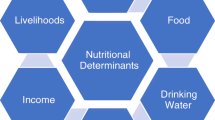Abstract
Nutritional status of 1243 children (636 boys and 607 girls) in the age group of 7–13 years was assessed in relation to utilisation of Integrated Child Development Services (ICDS) during their childhood. All the houses in every 10th Anganwadi selected by systematic random sampling were surveyed in the ICDS project, Nand Nagri in East Delhi. Information regarding utilisation of ICDS facilities, sociodemographic details, general awareness etc. was collected by interview technique and anthropometric and clinical examination of every child was done and Anganwadi attendance score was calculated for each child. It was found that most of the children were nonbeneficiaries (59.1%). On univariate analysis Anganwadi attendance score, age, sex of the child and education status of the father showed statistically significant association (p<0.005) with malnutrition. On Multiple logistic regression analysis higher age (OR 1.4155 for grade 1 malnutrition and 1.6913 for grade 4 malnutrition) and being female (OR 1.5214 for Grade 4 malnutrition) remained significant risk factors for development of malnutrition for all grades. Anganwadi attendance score did not show any statistically significant association for decreasing the risk of getting malnourished for any grades of malnutrition in 7–13 years age group. There is special need to take special care for girls as well as to continue the special nutrition care even at an higher age. More in depth studies are needed so as to formulate effective nutritional policies for children.
Similar content being viewed by others
References
Monitoring, motivation and continuing education, evaluation, research and training system in ICDS.Integrated Child Development Services. Central Technical Committee, ICDS, Department of Women and Child Development, Ministry of Human Resource Development 1994.
National Workshop on Early Childhood Development—A Report. Department of Women and Child Development, Ministry of Human Resource Development, Government of India with World Bank and UNICEF Co-operation.
National Evaluation of Integrated Child Development Services. National Institutre of Public Co-operation and Child Development, New Delhi 1992.
Tandon BN.Integrated Child Development Services. Nutrition Foundation of India 1992.
Sachdeva Y, Tandon BN. Survey.Education and Research System in Integrated Child. Development Services 1975-1995. Central Technical Committee, Integrated Mother and Child Development, New Delhi 1996.
Jellife DB. The assessment of the nutritional status of the community.WHO Monograph Series No 53. Word Health Organisation, Geneva: 1966.
Nutritional sub committee of Indian Association of Pediatrics. Classification of Protein Calorie Malnutrition.Indian Pediatr 1972; 9: 360–366.
National Nutrition Monitoring Bureau. Report of the NNMB-NSSO linked survey-1983. National Institute of Nutrition, Hyderabad, India 1983.
Gopalan C. The mother and child in India.Economics and Political Weekly 1985; 20:162–169.
Rao S, Joshi S, Kanode A. height, velocity, body fat and menstrual age of Indian girls.Indian Pediatr 1998; 35: 619–628.
Aggarwal DK, Aggarwal KN Upadhyay SKet al Physical and sexual growth pattern of effluent Indian children from 5 to 18 years of age.Indian Pediatr 1992; 29:1203–1282.
Mota L. Diarrhoeal diseases as cause of malnutrition.Am Med Hyg 1992; 47:16–27.
Khan A.Health practices in Uttar Pradesh. Operation Research group, Baroda, India 1986.
Callous implementation of midday meal scheme.The Hindustan Times dated 12.7.2000.
Sharma S. Nutrition in adolescent girls. In. Sachdeva HPS, Chaudhary P, eds.Nutrition in Children —Developing Country Concerns. National Update on Nutrition in Children, MAMC, New Delhi 1994: 272–281.
Gopalan C, Kaur H.Towards Better Nutrition (Special Publication Series 9). Nutrition Foundation of India, New Delhi 1993: 342–358.
Hobcroft J. Women’s education, child welfare and child survival. A review of the evidence.Health Transition Review 1993; 3:159–175.
Caldwell J C. How is greater maternal education translated into lower child mortality?Health Transition Review 1994; 4: 224–229.
Kennedy E, Slack A.The Integrated Child Development Services (ICDS) in India. Lessons learnt and implications for future policies. International Food Policy Research Institute, Washington DC 1993.
Author information
Authors and Affiliations
Corresponding author
Rights and permissions
About this article
Cite this article
Bhasin, S.K., Bhatia, V., Kumar, P. et al. Long term nutritional effects of ICDS. Indian J Pediatr 68, 211–216 (2001). https://doi.org/10.1007/BF02723191
Issue Date:
DOI: https://doi.org/10.1007/BF02723191



